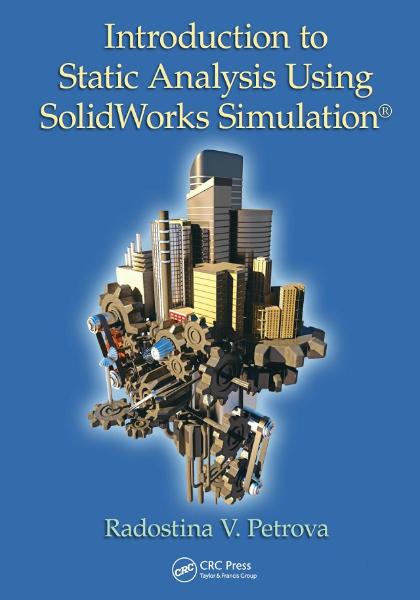اختصاصی از
فی موو آموزش سالیدورکس، کتاب مقدمه ای بر تحلیل استاتیکی با استفاده از SolidWorks Simulation دانلود با لینک مستقیم و پر سرعت .


کتاب مقدمه ای بر تحلیل استاتیکی با استفاده از سالیدورکس سیمولیشن (Introduction to Static Analysis Using SolidWorks Simulation)، مشتمل بر 9 فصل، 348 صفحه، به زبان انگلیسی روان، تایپ شده، به همراه کلی تصاویر، با فرمت PDF، به ترتیب زیر گردآوری شده است:
Chapter 1: Introduction
- Objectives of the Book
- Basics Concepts of FEM
- Basic Steps of All Engineering Software, Based on FEM
- SW Simulation as a Package for FEA2
Chapter 2: Development of a Finite Element Model of a Body (Pre-Processor Stage)
- Description of Functions of Physical Model
- Development of the Geometrical Model in SolidWorks
- Some More Perquisite Knowledge before Development of SW Simulation Model
- Introducing the Material of the Body
- Introducing the Fixtures to the Body
- Introducing the Loads to the Body
Chapter 3: Development of a Finite Element Model of a Body (Processor Stage)
- How Does Finite Element Analysis Work
- What Are the FEs and the Mesh
- Meshing of the Analysed Body
- Running the FEA
Chapter 4: Visualising and Systematising the Results of FEA (Post-Processor Stage)
- Setting the Analysis and the Results Preferences
- Different Ways to Systematise and Plot the Results of FEA
- Listing the Results of the Analysis
- Drawing Graphs of the Analysis Results
Chapter 5: Impact of Mesh Density and Viewing Mode on Final Results
- Different Types of FEs, Regarding the Geometry of the Model
- Impact of Mesh Density, When Standard Solid Mesh Is Used
- Impact of Mesh Density, When Curvature-Based Solid Mesh Is Used
- Impact of Mesh Density on Calculation Time and Accuracy
- Comparison between the Node Mode and the Element Mode
- Final Recommendations on Selection of Mesh Type
Chapter 6: Static Analysis of Solid Body with Circular or Planar Symmetry
- Development of CAD Models of the Analysed Bodies
- Static Analysis of the Designed Symmetrical Machine Unit with Circular Symmetry
- Static Analysis of the Designed Symmetrical Machine Units with a Planar Symmetry
Chapter 7: Static Analysis of a Shell Body
- When Can an Object Be Treated as a Shell? Thin or Thick Shell FEs?
Different Approaches for FEA of a Shell in SW Simulation
- Development of a CAD Model of a Shell Using Surface Tool
(Surface.sldprt)
- FEA of a Shell, Created Using Surface Tool (Surface.sldprt)
- Development of a CAD Model of a Shell Using Sheet Metal Tool
(Sheet_Metal.sldprt)
- FEA of the Shell, Created Using Sheet Metal Tool (Sheet_Metal.sldprt)
- Comparison of the Results from the Two Case Studies
Chapter 8: Static Analysis of a Frame Body
- Beams or Trusses
- Development of a CAD Model of a 3D Frame
- Calculation of a 3D Frame of Trusses
- Calculation of a 3D Frame of Beams
Chapter 9: Static Analysis of a Complex Structure
- CAD Model of the Studied Structure
- Static Finite Element Analysis of the Structure
- Comparison of the Results of the Sixth Design Scenarios
* توجه: کاربران نگران زبان انگلیسی کتاب نباشند. حتی کاربرانی که سر انگشتی زبان انگلیسی یاد دارند قادر خواهند بود از این کتاب بهره کافی را ببرند. لازم به ذکر است که آموزش در کتاب مقدمه ای بر تحلیل استاتیکی با استفاده از سالیدورکس سیمولیشن به صورت قدم به قدم (Step to Step) همراه با تصاویر می باشد.

جهت خرید کتاب مقدمه ای بر تحلیل استاتیکی با استفاده از سالیدورکس سیمولیشن (Introduction to Static Analysis Using SolidWorks Simulation)، به مبلغ فقط 3000 تومان و دانلود آن بر لینک پرداخت و دانلود در پنجره زیر کلیک نمایید.
!!لطفا قبل از خرید از فرشگاه اینترنتی کتیا طراح برتر قیمت محصولات ما را با سایر فروشگاه ها و محصولات آن ها مقایسه نمایید!!
!!!تخفیف ویژه برای کاربران ویژه!!!
با خرید حداقل 20000 (بیست هزارتومان) از محصولات فروشگاه اینترنتی کتیا طراح برتر برای شما کد تخفیف ارسال خواهد شد. با داشتن این کد از این پس می توانید سایر محصولات فروشگاه را با 20% تخفیف خریداری نمایید. کافی است پس از انجام 20000 تومان خرید موفق عبارت درخواست کد تخفیف، شماره همراه و ایمیلی که موقع خرید ثبت نمودید را به ایمیل فروشگاه (catia2015.sellfile@gmail.com) ارسال نمایید. همکاران ما پس از بررسی درخواست، کد تخفیف را به ایمیل شما ارسال خواهند نمود.
دانلود با لینک مستقیم
آموزش سالیدورکس، کتاب مقدمه ای بر تحلیل استاتیکی با استفاده از SolidWorks Simulation 



